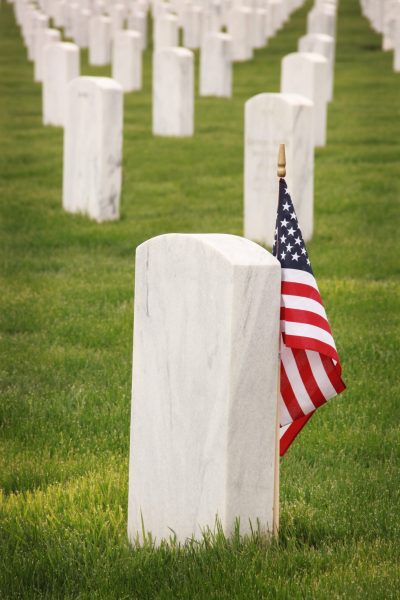The History of Memorial Day

The head of an organization of Union veterans from the Civil War, the Grand Army of the Republic (GAR), established Decoration Day on May 5, 1868, just three years after the Civil War had ended. This day would be a time when the nation would decorate graves of the war dead with flowers. The date was declared to be May 30 by Maj. Gen. John A. Logan.
“The 30th of May, 1868, is designated for the purpose of strewing with flowers, or otherwise decorating the graves of comrades who died in defense of their country during the late rebellion, and whose bodies now lie in almost every city, village and hamlet churchyard in the land,” he proclaimed.
While there is some mystery as to why this particular date was chosen, there are a couple of suggested reasons. One reason this date is believed to be chosen is because flowers would be in bloom all over the country. The other reason given, and is more often noted, is because it wasn’t the anniversary of any particular battle.
Across the Potomac River from Washington D.C., the first large observance of the new holiday was held that year at Arlington National Cemetery. This cemetery is the country’s first national cemetery, and was established due to the Civil War taking so many American lives. In fact, this war took more American lives than any other conflict in American history.
Once the home of Gen. Robert E. Lee, the veranda of the Arlington Mansion was the center of the ceremonies. Speeches were given, most notably by former Union General and sitting Ohio Congressman James Garfield, before children from the Soldiers’ and Sailors’ Orphan Home and members of the GAR put flowers on the graves of both Union and Confederate Soldiers, reciting prayers and singing hymns as they did so. Around 5,000 participants decorated the more than 20,000 Union and Confederate graves that day.
Reprising the tradition in subsequent years, many Northern states held similar commemorative events. By 1890, Decoration Day would be an official state holiday in these states. Southern states, however, would continue to honor the dead on separate days until World War I.
Prior to this, local springtime observances had already been held for the Civil War dead. Columbus, Mississippi is known to have held one of the first on April 25, 1866, when a group of women decorated the graves of Confederate soldiers who had died in the battle at Shiloh. Graves of Union soldiers nearby had been neglected, as they were the enemy. However, these women were disturbed by the bareness of the graves, and began placing flowers on them as well. In Charleston, South Carolina, freed slaves organized to pay tribute and give proper burials to Union troops the year prior on May 1, less than a month after the Confederacy surrendered.
Today, about 25 places, both in the North and South, have been named in connection to the origin of Memorial Day—many of these places being in the South, however, as that is where most of the war dead are buried.
Waterloo, New York would be declared the official birthplace in 1966 by Congress and President Lyndon Johnson. It was there that a ceremony honoring local veterans that fought in the Civil War had commenced on May 5, 1866. Supporters of this declaration say earlier observances were either “informal,” not community-wide, or were simply one-time events. In Waterloo, it was an annual, community-wide event where businesses closed and resident would decorate graves of soldiers with flowers and flags. It was in New York where Memorial Day was declared a legal holiday for the first time by a state in 1873.
Memorial Day ceremonies were being held on May 30 across the nation by the end of the 19th century. Proclamations were passed by State Legislatures, designating the day, and regulations were adopted by the Army and Navy for proper observance at their facilities.
After World War I, the day was expanded to honor those who died in all American wars. Interestingly, this is also the war that brought the red poppy flower into play. These flowers are worn by some people during Memorial Day to remember the fallen soldiers. The red poppy comes from a poem by John McCrae, a World War I brigade surgeon who saw the red flowers growing in a ravaged battlefield and was inspired to write the war poem, ‘In Flanders Field.’
Inspired by McCrae’s poem, Moina Michael replied with her own poem in 1915 in her book, ‘The miracle flower: the story of the Flanders Fields memorial poppy.’
We cherish too, the Poppy red That grows on fields where valor led, It seems to signal to the skies That blood of heroes never dies.
She conceived the idea to wear red poppies on Memorial Day in honor of those who died serving the nation during war. She was the first to wear one and sold poppies to her friends and co-workers, using the money to benefit servicemen in need.
Visiting the U.S. from France, Madam Guerin learned of this new custom, and loved it so much that when she returned to her home country, she began making artificial red poppies to raise money for war orphaned children and widowed women. This tradition would soon spread to other countries, as well. To benefit war orphans of France and Belgium the Franco-American Children’s League sold poppies nationally in 1921, but disbanded a year later. Looking for help, Madam Guerin went to the Veterans of Foreign Wars (VFW). Shortly before Memorial Day 1922, the VFW would become the first veteran’s organization to nationally sell poppies. The U.S. Post Office would go on to honor Ms. Michael by issuing a red three cent postage stamp with her likeness on it in 1948 for her role in founding the National Poppy movement.
By an act of Congress in 1968, known as the Uniform Monday Holiday Act, Memorial Day was declared a federal holiday, and was put into effect in 1971, though it is still often called “Decoration Day.” This was also when the day it was celebrated changed from May 30 to the last Monday in May.
In addition to this official federal holiday, many Southern states still have a separate day to honor the Confederate war dead: January 19th in Texas; April 26th in Alabama, Florida, Georgia, and Mississippi; May 10th in South Carolina; and June 3rd (Jefferson Davis’ birthday) in Louisiana and Tennessee.
A resolution was also passed in December 2000, asking that at 3 p.m. local time that all Americans “voluntarily and informally observe in their own way a Moment of remembrance and respect, pausing from whatever they are doing for a moment of silence or listening to ‘Taps.’”
Thanks for reading. Be sure to share and subscribe. You can also help support independent journalism in Kansas at buymeacoffee.com/kscon.

Ian Brannan
Ian Brannan is an independent journalist who founded The Kansas Constitutional in April 2022. His work focuses on issues including abortion, Convention of States, drug policy, education, government, LGBT issues, media, and more. He is also the co-host of the Rainbow Rabble-Rousers podcast.

